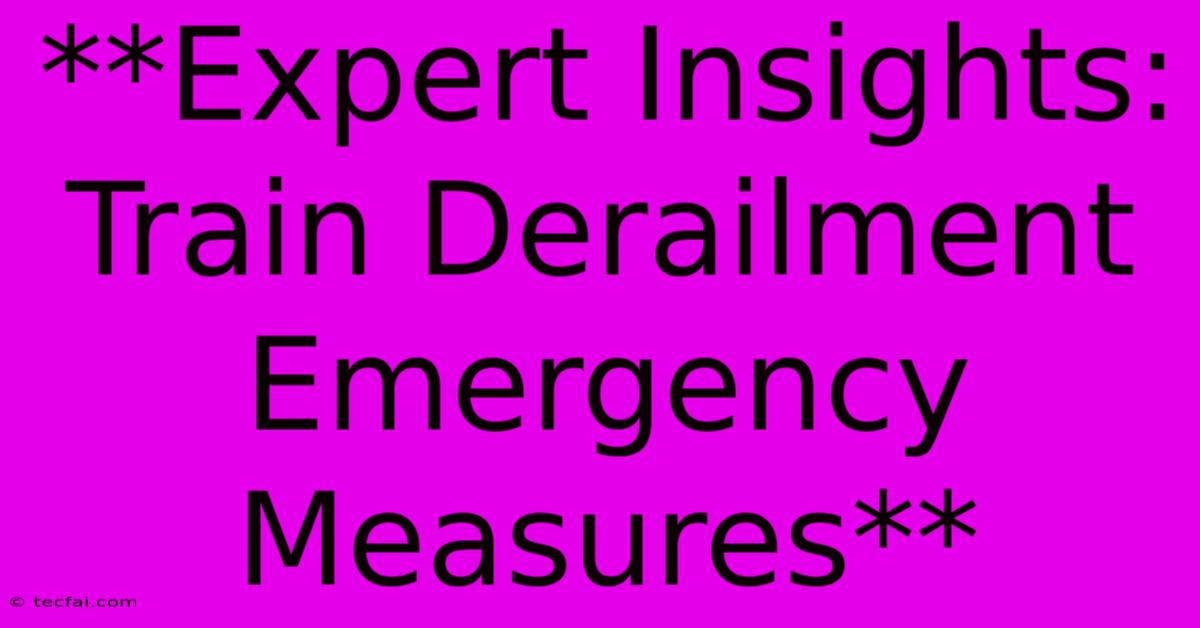**Expert Insights: Train Derailment Emergency Measures**

Discover more detailed and exciting information on our website. Click the link below to start your adventure: Visit Best Website tecfai.com. Don't miss out!
Table of Contents
Expert Insights: Train Derailment Emergency Measures
Train derailments, though thankfully infrequent, represent significant safety concerns demanding meticulous emergency preparedness. This article delves into expert insights on effective emergency measures following such incidents, focusing on response strategies, evacuation procedures, and post-incident recovery. Understanding these critical aspects is crucial for both railway operators and the public.
Immediate Response: The First Crucial Hours
The initial response to a train derailment dictates the outcome for those involved. Swift and coordinated action minimizes casualties and further damage.
Emergency Services Coordination:
- Rapid Dispatch: The speed of emergency services deployment is paramount. Efficient communication networks, including dedicated hotlines and real-time location tracking, are vital for ensuring ambulances, fire departments, and specialized hazmat teams reach the scene promptly.
- Unified Command: Establishing a unified command structure, with clear lines of authority and communication, ensures a coordinated response among different agencies. This prevents duplication of effort and promotes efficient resource allocation.
- Hazard Identification: Immediate assessment of the derailment site is crucial to identify potential hazards like spilled hazardous materials, fire, or structural instability. This assessment guides the deployment of specialized teams and appropriate safety equipment.
Securing the Scene:
- Establishing a Perimeter: A secure perimeter around the derailment site is essential to prevent unauthorized access and protect first responders and the public from potential dangers. This includes controlling traffic and pedestrian movement.
- Controlling Hazardous Materials: If hazardous materials are involved, specialized teams must contain and neutralize the threat. This involves deploying containment booms, absorbent materials, and other specialized equipment.
- Rescue Operations: Prioritizing the rescue of trapped passengers and crew is paramount. This often involves utilizing specialized equipment like hydraulic rescue tools and heavy lifting gear. Medical personnel must be on-site to provide immediate care to the injured.
Evacuation Procedures: Safe and Orderly Removal
Efficient and safe evacuation procedures are critical in minimizing casualties and ensuring the well-being of passengers and nearby residents.
Passenger Assistance:
- Clear Instructions: Passengers require clear, concise, and calm instructions during an evacuation. Pre-planned evacuation routes and well-marked signage are crucial. Regular safety drills help passengers familiarize themselves with these procedures.
- Assisted Evacuation: Assistance must be provided for passengers with mobility limitations or other special needs. Trained personnel should be readily available to assist in their safe removal from the train.
- Designated Assembly Points: Designated assembly points away from the derailment site are essential for ensuring an accurate count of passengers and identifying those requiring medical attention.
Community Evacuation (if necessary):
- Early Warning Systems: Effective early warning systems are crucial to alert residents in the vicinity of a derailment, especially if hazardous materials are involved. This could include sirens, public address systems, and emergency alerts via mobile devices.
- Evacuation Routes: Pre-planned evacuation routes for nearby communities should be well-marked and regularly updated. Community awareness programs educating residents about these routes are crucial.
- Shelters and Support: Designated shelters should be established to provide temporary refuge and support for evacuated residents. This includes access to food, water, medical assistance, and information.
Post-Incident Recovery: Investigation and Lessons Learned
The aftermath of a train derailment requires a thorough investigation to determine the cause and implement preventative measures to avoid future occurrences.
Accident Investigation:
- Thorough Examination: A comprehensive investigation involving experts from various fields (engineering, safety, and transportation) is needed to determine the root cause of the derailment. This often involves analyzing data recorders, examining the train's physical condition, and reviewing operational procedures.
- Regulatory Compliance: The investigation must assess compliance with relevant safety regulations and identify any shortcomings that contributed to the accident. This process often involves collaborating with regulatory bodies.
- Public Transparency: Open and transparent communication with the public regarding the investigation's findings and the steps being taken to prevent future incidents is vital to rebuild trust and confidence.
Implementing Preventative Measures:
- Improved Safety Standards: The findings from the investigation should lead to improvements in safety standards, including enhanced track maintenance, advanced signaling systems, and improved train design.
- Enhanced Training: Regular and comprehensive training for railway personnel on emergency procedures and safety protocols is crucial to ensure preparedness. This includes refresher courses and simulated emergency drills.
- Technological Advancements: The integration of advanced technologies, such as predictive maintenance systems and real-time monitoring tools, can help identify potential risks and prevent future derailments.
Train derailments are complex emergencies requiring a coordinated, multi-faceted approach. By strengthening emergency preparedness strategies, improving response mechanisms, and rigorously investigating incidents, the railway industry can significantly enhance safety and mitigate the impact of future derailments. The key lies in proactive planning, robust training, and a commitment to continuous improvement.

Thank you for visiting our website wich cover about **Expert Insights: Train Derailment Emergency Measures**. We hope the information provided has been useful to you. Feel free to contact us if you have any questions or need further assistance. See you next time and dont miss to bookmark.
Featured Posts
-
Treaty Bill What Happened At First Reading
Nov 16, 2024
-
Are Zuckerberg And Musk Opposing Forces
Nov 16, 2024
-
Caribbean Tour Ends Early For Topley Due To Injury
Nov 16, 2024
-
Limited Pitbull Tickets Uk Tour Final Sale
Nov 16, 2024
-
Secure Pitbull Dublin Tickets Pre Sale Guide
Nov 16, 2024
